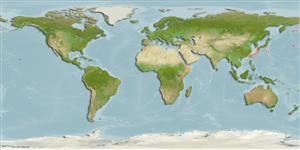Klassifizierung / Names
Namen | Synonyme | Catalog of Fishes(Gattung, Arten) | ITIS | CoL | WoRMS | Cloffa
Elasmobranchii (Haie und Rochen) (sharks and rays) >
Carcharhiniformes (Ground sharks) >
Pentanchidae (Deepwater catsharks)
Etymology: Galeus: galeos, a small shark or dogfish according to Aristotle and others. (See ETYFish); longirostris: longus (L.), long; rostris, from rostrum (L.), snout, referring to its “considerably longer” snout compared with congeners known at the time. (See ETYFish).
Environment: milieu / climate zone / depth range / distribution range
Ökologie
seewasser bathydemersal; tiefenbereich 440 - 520 m (Ref. 58018). Deep-water
Northwest Pacific: Amami-oshima, the Ogasawara and Izu islands.
Size / Gewicht / Alter
Maturity: Lm ? range ? - ? cm
Max length : 80.3 cm TL Männchen/unbestimmt; (Ref. 12694)
Life cycle and mating behavior
Maturities | Fortpflanzung | Spawnings | Egg(s) | Fecundities | Larven
Tachikawa, H. and T. Taniuchi, 1987. Galeus longirostris, a new species of the sawtail catshark from Japan. Jap. J. Ichthyol. 33(4):352-359. (Ref. 12694)
IUCN Rote Liste Status (Ref. 130435)
Bedrohung für Menschen
Harmless
Nutzung durch Menschen
Tools
Zusatzinformationen
Download XML
Internet Quellen
Estimates based on models
Preferred temperature (Ref.
123201): 2.7 - 7.3, mean 4.6 °C (based on 103 cells).
Phylogenetic diversity index (Ref.
82804): PD
50 = 0.5000 [Uniqueness, from 0.5 = low to 2.0 = high].
Bayesian length-weight: a=0.00355 (0.00176 - 0.00714), b=3.09 (2.91 - 3.27), in cm total length, based on LWR estimates for this (Sub)family-body shape (Ref.
93245).
Trophic level (Ref.
69278): 4.1 ±0.2 se; based on size and trophs of closest relatives
Widerstandsfähigkeit (Ref.
120179): niedrig, Verdopplung der Population dauert 4,5 - 14 Jahre. (Fec assumed to be <100).
Fishing Vulnerability (Ref.
59153): Moderate to high vulnerability (52 of 100).
